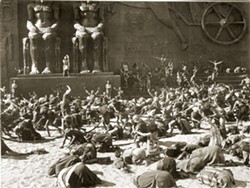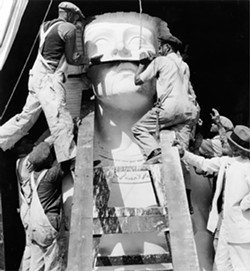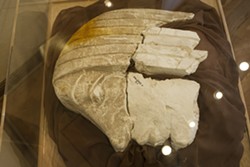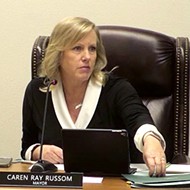Epic excavation
After years of speculation, surveys, and red tape, the set of Cecil B. DeMille's 1923 production of The Ten Commandments has been partially recovered and preserved
By Joe Payne[{
"name": "Ad - Medium Rectangle CC01 - 300x250",
"id": "AdMediumRectangleCC01300x250",
"class": "inlineCenter",
"insertPoint": "8",
"component": "2963441",
"requiredCountToDisplay": "12"
},{
"name": "Ad - Medium Rectangle LC01 - 300x250",
"id": "AdMediumRectangleCC01300x250",
"class": "inlineCenter",
"insertPoint": "18",
"component": "2963441",
"requiredCountToDisplay": "22"
},{
"name": "Ad - Medium Rectangle LC09 - 300x250",
"id": "AdMediumRectangleLC09300x250",
"class": "inlineCenter",
"insertPoint": "28",
"component": "3252660",
"requiredCountToDisplay": "32"
}]
Driving along the main street of flat, sleepy Guadalupe—population less than 8,000, according to the most recent census reports—there’s little evidence that gilded chariots driven by film extras once raced up and down the town’s thoroughfare. And walking along the timeless stretches of sand Guadalupe boasts of in its motto, “Gateway to the dunes,” you could be forgiven for overlooking the mammoth pharaoh heads and sphinxes sleeping in their bed of sand.
But if Indiana Jones has taught us anything, it’s that things aren’t always what they seem, and historic treasures can turn up in the unlikeliest of places, often after patiently biding their time for centuries or even thousands of years.
And while the organizers behind most archaeological excavations hope to unearth ancient or prehistoric artifacts, a local project is casting its gaze back a mere 90 years. Thanks to a cryptic passage from the posthumously published biography of Cecil B. DeMille—often considered to be the father of American cinema—the artifacts from a historic movie set from the silent film era have been identified, painstakingly recovered, and are now on display for anyone who can make the trek to the Guadalupe-Nipomo Dunes Center.
While the 1956 version of The Ten Commandments with Charlton Heston is a well-known movie, it was actually a remake of DeMille’s earlier, silent version of the epic Biblical story. Unlike the later film, which DeMille shot in Egypt, the silent version used Guadalupe for its scenes depicting the Jews’ now legendary exodus from Egypt led by Moses.
The Guadalupe-Nipomo Dunes Center is playing host to the findings of a private excavation; the effort involved several archaeologists, but was spearheaded by filmmaker Peter Brosnan, who’s working on a documentary. Literally decades in the making, the film is about the find and the excavation, with the excavation proving much more challenging than the filming process for a number of fiscal and bureaucratic reasons.
A public unveiling of the newly recovered set pieces—which have been conserved by art restoration experts at the Hollywood Heritage Museum—took place at the Guadalupe-Nipomo Dunes Center on June 14. The event was speakeasy themed, celebrating the era in which the historical film was made.
Genesis of an icon
Cecil B. DeMille was one of many stage turned-film directors in the early 1900s, helming his first movie in 1913. Just a decade after his initial project, DeMille had become a hugely respected director, garnering countless fans and Hollywood support.
The genesis of The Ten Commandments was a publicity stunt coordinated by DeMille and the Los Angeles Times, who jointly offered $1,000 to whoever came up with the idea for DeMille’s next epic film. More than one reader suggested the Biblical exodus as a suitable topic for the project, and powerhouse director agreed.
An artist of authenticity, DeMille hoped to shoot The Ten Commandments in Egypt—an idea his backers, however, were reticent to fund. The small town of Guadalupe, relatively close to Los Angeles, made more fiscal sense.
“Any time a film needed some place that looks like Africa or the Middle East, Guadalupe is a lot more pleasant a place to work than the desert,” said Doug Jenzen, executive director of the Guadalupe-Nipomo Dunes Center.
But the Dunes Center isn’t just interested in the afterglow of the Hollywood elite wafting across the crests and valleys of the dunes. The story of The Ten Commandments is also the history of Guadalupe, and the many people who witnessed or participated in the film.
“Peter Brosnan collected a lot of oral histories from the old timers out here, which was really forward-thinking of him,” Jenzen said.
The resulting tale explores the seemingly unlikely merger of the tiny town of Guadalupe and the machine that was the Hollywood film industry nearly a century ago.
“Because I began working on this in the 1980s, most of the people who worked on it were still alive,” Brosnan said. “I was able to interview the ranchers, wranglers, horse riders, and actors; they all related great stories about what it was like to be there on the dunes in 1923.”
Scope and size
Perched atop a sand dune, which is now in the Santa Barbara County Guadalupe-Nipomo Dunes Reserve, the set included a 120-foot-tall, 800-foot-wide facade of the “The City of the Pharaoh,” which required more than 70 miles of cable to keep upright. A group of sphinxes, each of which weighed five tons, flanked an avenue.
“One of the interesting aspects of this is that the majority of the population of Guadalupe at the time were Filipino and Japanese folks,” Jenzen said. “They couldn’t work in the movie at that time, so they were hired to build the set.”
DeMille’s production employed 1,600 laborers—the majority of whom were locals—to help build the wood frames and concrete and plaster set pieces. The huge sculptures were actually crafted by Paul Iribe, the famous artistic director of Vogue.
“The Guadalupe set is arguably the earliest extant three-dimensional work by Paul Iribe, the father of art deco,” Brosnan said. “It’s one of the interesting things about the project: So many fascinating people were involved in it.”
Once the massive set was finished, DeMille and his crew arrived. With the help of the military, the director had a huge camp built on the sand dune adjacent to where they were filming. It boasted 500 tents for actors, camera operators, lighting technicians, makeup artists, and military members. There was a hospital tent, projection room tent, and even a giant mess tent that could seat up to 1,500 people.
“DeMille was certainly the master of the Biblical epic,” Brosnan said, “and the master of putting a thousand people on screen, which nobody else could do.”
Once he was finally ready to shoot, DeMille called on locals to help fill out his epic exodus scene. The Santa Maria Valley was already a booming agricultural area on the Central Coast, and local ranchers were more than ready to hire out not just themselves as extras, but their animals, too. The exodus scene included 2,500 actors and 3,000 animals.
“They needed those farm animals, so they would hire anybody who let them use their farm animals,” Jenzen said, “and then they needed people to take care of those animals; so, if you were local and worked in Guadalupe, you worked in the movie.”
Brosnan has tracked down a number of anecdotes about the production from the old-timers he interviewed in the early ’80s. Some of these ranchers-turned-actors included Ernest Righetti and Clarence Minetti.
“We even talked to one guy who rented his horse in return for a car ride back to town,” Brosnan said. “He had never ridden in a car before that.”
DeMille, who was famous for his strict rules of conduct on set, also hired a kind of vice police to patrol the tents and make sure there wasn’t any undesirable activity going on. Some of the cultural artifacts recovered include the Prohibition Era “cough syrup” bottles, a clue that perhaps illegal alcohol consumption was some of the behavior DeMille was trying to restrict.
“In those days Guadalupe was a wide open town, what we would call a red light district today,” Brosnan said. “DeMille hired soldiers to construct his camp, and they had a good time after hours.”
The soldiers and crew would come to town often to indulge in activities not sanctioned by DeMille. And, though nobody remembers exactly who was driving the chariots from the film, the reproductions of ancient vehicles were used as practical—and impractical—transport.
“When they were off duty, they would ride their chariots to town,” Brosnan said. “There were some really wild chariot races up and down the street, which the public just loved.”
Once the principle photography requiring the set was finished, DeMille had little use for it. Though he had agreed to remove all of the construction when he first got the permits to film in Santa Barbara County, DeMille wasn’t prepared to ship thousands of tons of concrete, plaster, and the rest back to Hollywood.
“There are two theories as to why, the first being that he ran out of money and the film was so costly that he couldn’t afford to take everything back with him to Hollywood,” Jenzen said. “The second theory is that if he didn’t bury it, someone else would find the set and use it to make a movie with hardly any of the cost.”
Unbeknownst to the community and the county permits office, DeMille dynamited the base of the huge Egyptian temple face, which fell backward and was buried. He used an early form of the bulldozer to dig a ditch and push in all 21 of the massive sphinx statues. Piles of garbage and unnecessary items were buried as well, leaving clues as to how the cast and crew lived while making motion picture history on the Guadalupe Dunes.
Excavating the exodus
|
|
The only clue Cecil B. DeMille left regarding the massive set of The Ten Commandments waiting under the sands of Guadalupe came in his autobiography, which was published posthumously.
“If 1,000 years from now, archaeologists happen to dig beneath the sands of Guadalupe,” the filmmaker wrote, “I hope that they will not rush into print with the amazing news that Egyptian civilization, far from being confined to the Valley of the Nile, extended all the way to the Pacific coast of North America.”
That small paragraph set a handful of Hollywood film buffs on the trail of the “Lost City of DeMille.” Brosnan, who was involved from the beginning of the project as a documentarian, was one of the first to stand on the site while aware of what rested underneath.
“There’s evidence out there in the sand of one of the biggest motion picture sets ever built,” he said. “What’s out there is a piece of an era in film that has never been matched, and never will be.”
In 1983—Brosnan, along with Bruce Cardoza and Richard Eberhardt—traveled to the site, led by local Joe Gray. After digging into the sand, they found the sculpted face of a horse, which they recognized from the wall of the giant set façade. They also began uncovering other plaster pieces and cultural artifacts. Unfortunately, due to a lack of financial support and county permits, the project was deserted, much like the set.
“I left the project, but something I hadn’t expected—the project hadn’t left me behind,” he said. “We apparently created a project that just kept generating interest.”
After the DeMille family gave Brosnan a grant to digitize the interviews he collected from people involved in the project, interest was piqued. The Los Angeles Times, echoing its early support for DeMille, reported on efforts to uncover the set of The Ten Commandments. This brought Brosnan worldwide attention, including that of a woman in Texas who contacted him and agreed to fund the rest of the project, excavation and film included.
Though Brosnan received the financial support he needed, getting permitting and permission was another story. In the early ’90s, with the help of archaeologist D. John Parker, the team was able to use ground-penetrating radar to locate much of the set, without doing any real digging. Once prepared to actually dig, literally one business day before the excavation was set to take place, the Santa Barbara County permitting office rescinded the permit, claiming it had issued the wrong kind of permit, Brosnan explained.
“Parker had spent the better part of a year going to County Parks and getting all the permits we needed,” Brosnan said. “He left in disgust, but he connected us with another archaeology company based out of Santa Barbara.”
Once the permitting situation was finally figured out, the excavation party still had to wait. The Ranch Guadalupe Wildlife Preserve, which includes much of the Guadalupe-Nipomo Dunes, is a protected sanctuary for the western
snowy plover, an endangered bird that nests on the dunes. Plover season runs from March through the beginning of October—so late that autumn, hoping to beat the winter rains, the team spent two weeks excavating.
“It was pretty exciting,” Brosnan said. “Sadly, we had found that much of the material we found 20 years ago has been destroyed. We learned that sand is a wonderful preservative; there is a virtual history museum buried and preserved in the sand.”
The sand acted as a natural desiccant, preserving materials used to make the films, including some costume pieces. Unfortunately, when what was once preserved becomes exposed to the wind and moisture in the air, it quickly falls apart.
One man’s trash …
|
|
“The first time I ever saw the site, I didn’t know it was the site,” Jenzen said. “I just wondered why there was trash all over the sand dune.”
Many of the cultural artifacts are being kept by the Dunes Center on behalf of Santa Barbara County, which technically owns them. The large set pieces recovered by Brosnan have been taken to Los Angeles to the Hollywood Heritage Museum where they’ve being restored for the unveiling on June 14.
“We have an art conservatory down here,” Brosnan said. “Amy Higgins—she specializes in plaster reconstruction and restoration—she is working on restoring the pieces and creating exhibit pieces for them.”
The unveiling will be a watermark for Brosnan, but not the last. He hopes to complete the documentary film cataloging the project soon and possibly debut it at the Santa Barbara International Film Festival.
“At times, this has been a real pain in the butt,” he said, “but now that it’s all over I am very happy that I have had the chance to interview everybody and show this history and tell this story.”
Though the excavation unearthed quite a lot of artifacts, it only scratched the surface, Brosnan explained; there’s still quite a lot of the set out there. The Dunes Center’s display capability is limited by what can fit inside its doors, so the larger set pieces remain unrecovered.
“When the report on this project is done, it will show that there is a lot more out there,” Brosnan said. “I hope the exhibit at the Dunes Center will encourage people to go out and uncover a lot of the wonderful things out there.”
Though Brosnan is done with his project, other professional groups can apply for permitting from the county to try to excavate the set. Note that members of the general public aren’t allowed to remove any set pieces from the site without facing legal action from the county.
“It’s part of our public heritage and heritage of the area,” Jenzen said. “It’s actually the last surviving movie set from early Hollywood.”
The majority of silent era films are lost, Brosnan explained. Not just the films, but also the sets and artifacts used to make them. That’s what makes The Ten Commandments set so special: It’s a well preserved window into a time when the 20th century’s dominant art form was still developing.
“I always have to laugh when I see a film crew on the dunes,” Brosnan said. “They are out there using movie-making language; well, 90 years ago DeMille was out there inventing that language.”
Brosnan also sees the current project and any possible future iterations as a golden opportunity for Guadalupe and the area’s tourism.
“There’s a little town up in the Sierras, Lone Pine, and a lot of films were shot out there in the 1930s, and they have turned it into a tourist destination,” he said. “I think Guadalupe could do that same thing. I would love to see a classic film festival at their theater. It’s a classic town with connections to a lot of classic Hollywood movies.”
Joe Payne is Arts Editor at New Times’ sister paper, the Santa Maria Sun. Send comments to [email protected].
Latest in News
Readers also liked…
-

Coast Unified teachers upset over new position's salary and qualifications
Oct 20, 2022 -

SLO police identify alleged driver who hit and killed couple
Dec 22, 2022 -

When the levee breaks: Oceano residents, county officials walk a tightrope of regulations to manage Arroyo Grande Creek, which some say led to the levee's failure in January
May 18, 2023











